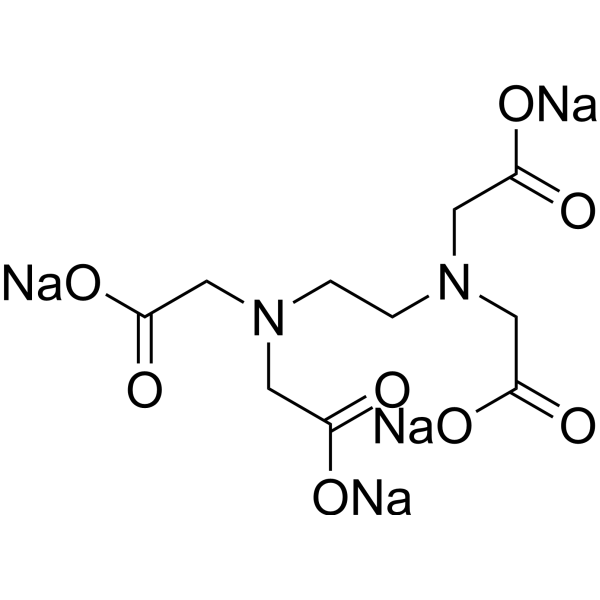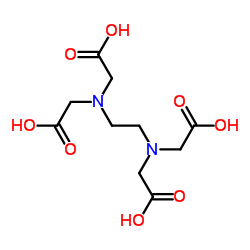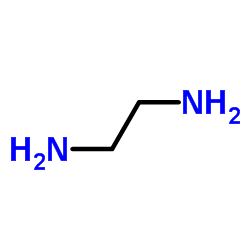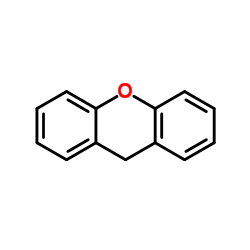64-02-8
| Name | EDTA tetrasodium |
|---|---|
| Synonyms |
Ethylenediaminetetraacetic acid tetrasodium salt
Tetrasodium 2,2',2'',2'''-(1,2-ethanediyldinitrilo)tetraacetate Tetrasodium ethylenediaminetetraacetate Tetrasodium salt EDTA MFCD00012460 EINECS 200-573-9 Glycine, N,N'-1,2-ethanediylbis[N-(carboxymethyl)-, tetrasodium salt Complexone TETRASODIUM EDTA Nullapon N,N'-Ethylenediaminediacetic acid tetrasodium salt TETRACEMATE TETRASODIUM Tetrasodium salt of EDTA EDTA tetrasodium salt Tetrasodium edetate Nervanaid B EDETIC ACID TETRASODIUM SALT EDTA sodium Tetrasodium 2,2',2'',2'''-(ethane-1,2-diyldinitrilo)tetraacetate Edetate Sodium EDTA Tetrasodium Endrate tetrasodium Sodium edetate EDTA-4NA |
| Description | Ethylenediaminetetraacetic acid (EDTA) tetrasodium is a metal chelators (binds to metal divalent and trivalent cations including calcium), which shows activities of anticoagulant and anti-hypercalcemic. Ethylenediaminetetraacetic acid tetrasodium decreases the metal ion-catalyzed oxidative damage to proteins, and allows maintenance of reducing environment during protein purification. Ethylenediaminetetraacetic acid tetrasodium can also decrease the formation of disulfide bonds[1][2][3]. |
|---|---|
| Related Catalog | |
| References |
| Density | 6.9 g/cm3 |
|---|---|
| Boiling Point | 614.2ºC at 760 mmHg |
| Melting Point | >300 °C(lit.) |
| Molecular Formula | C10H12N2Na4O8 |
| Molecular Weight | 380.17 |
| Flash Point | 325.2ºC |
| Exact Mass | 380.018433 |
| PSA | 167.00000 |
| Stability | Stable. Incompatible with strong oxidizing agents. |
| Water Solubility | H2O: 0.1 g/mL, clear, colorless |
|
Section 1: Product Identification Chemical Name:Ethylenediaminetetraacetic acid, tetrasodium salt tetrahydrate, 99+% CAS Registry Number:64-02-8 Formula:(NaOOCH2)2NCH2CH2N(CH2COONa)2.4H2O EINECS Number:200-573-9 Chemical Family:organic amine Synonym:N,N'-Ethylenediaminediacetic acid tetrasodium salt, Tetrasodium EDTA
Section 2: Composition and Information on Ingredients IngredientCAS NumberPercentACGIH (TWA)OSHA (PEL) Title Compound64-02-8100%no datano data Section 3: Hazards Identification Emergency Overview:Irritating to eyes, skin, and respiratory tract. Primary Routes of Exposure:Eyes, Inhalation of dust. Eye Contact:Irritating to eyes. May cause redness and pain. Skin Contact:Mildly irritating to skin. May cause itching and redness. Inhalation:Dust may be irritating to the nose, mucous membranes and respiratory tract. Ingestion:No specific information is available on the physiological effects of ingestion. Acute Health Affects:Irritating to skin, eyes and respiratory tract. Chronic Health Affects:No information available on long-term chronic effects. NTP:No IARC:No OSHA:No SECTION 4: First Aid Measures Immediately flush the eyes with copious amounts of water for at least 10-15 minutes. A victim may need Eye Exposure: assistance in keeping their eye lids open. Get immediate medical attention. Wash the affected area with water. Remove contaminated clothes if necessary. Seek medical assistance if Skin Exposure: irritation persists. Remove the victim to fresh air. Closely monitor the victim for signs of respiratory problems, such as difficulty Inhalation: in breathing, coughing, wheezing, or pain. In such cases seek immediate medical assistance. Seek medical attention immediately. Keep the victim calm. Give the victim water (only if conscious). Induce Ingestion: vomiting only if directed by medical personnel. SECTION 5: Fire Fighting Measures Flash Point:no data Autoignition Temperature:none Explosion Limits:none Extinguishing Medium:dry chemical, carbon dioxide, water fog, or foam. If this product is involved in a fire, fire fighters should be equipped with a NIOSH approved positive pressure Special Fire Fighting Procedures: self-contained breathing apparatus and full protective clothing. Hazardous Combustion andIf involved in a fire this material may emit toxic organic fumes. Decomposion Products: Unusual Fire or Explosion Hazards: No unusual fire or explosion hazards. SECTION 6: Accidental Release Measures Small spills can be mixed with vermiculite, sodium carbonate or other suitable non combustible adsorbent and Spill and Leak Procedures: swept up. SECTION 7: Handling and Storage Handling and Storage:Store in a tightly sealed container. Keep away from heat and direct sunlight. SECTION 8: Exposure Controls and Personal Protection Eye Protection:Always wear approved safety glasses when handling a chemical substance in the laboratory. Skin Protection:Wear appropriate chemical resistant gloves and clothing. Ventilation:Material may form a fine dust. If possible, handle the material in an efficient fume hood. If ventilation is not available a respirator should be worn. The use of respirators requires a Respirator Respirator: Protection Program to be in compliance with 29 CFR 1910.134. Ventilation:Material may form a fine dust. If possible, handle the material in an efficient fume hood. Additional Protection:No additional protection required. SECTION 9: Physical and Chemical Properties Color and Form:white xtl. Molecular Weight:380.18 (452.23) Melting Point:no data Boiling Point:no data Vapor Pressure:not applicable Specific Gravity:no data Odor:none Solubility in Water:soluble SECTION 10: Stability and Reactivity Stability:air and moisture stable Hazardous Polymerization:no hazardous polymerization Conditions to Avoid:none Incompatibility:oxidizing agents Decomposition Products:carbon monoxide, carbon dioxide, organic fumes, sodium oxide, sodium hydroxide and nitrogen oxides. SECTION 11: Toxicological Information Administration onto the skin (rabbit); Standard Draize test: 500 mg/24H. Administration into the eye (rabbit); RTECS Data:Standard Draize test: 1900 ug. Administration into the eye (rabbit); Standard Draize test: 100 mg/24H. Intraperitoneal (mouse); LD50: 330 mg/kg. Carcinogenic Effects:no data Mutagenic Effects:no data Tetratogenic Effects:no data SECTION 12: Ecological Information Ecological Information:No information available SECTION 13: Disposal Considerations Disposal:Dispose of according to local, state and federal regulations. SECTION 14: Transportation Shipping Name (CFR):Non-hazardous Hazard Class (CFR):NA Additional Hazard Class (CFR):NA Packaging Group (CFR):NA UN ID Number (CFR):NA Shipping Name (IATA):Non-hazardous Hazard Class (IATA):NA Additional Hazard Class (IATA):NA Packaging Group (IATA):NA UN ID Number (IATA):NA SECTION 15: Regulatory Information TSCA:Listed in the TSCA inventory. SARA (Title 313):Title compound not listed. Second Ingredient:none SECTION 16 - ADDITIONAL INFORMATION N/A |
CHEMICAL IDENTIFICATION
HEALTH HAZARD DATAACUTE TOXICITY DATA
|
| Hazard Codes | Xi:Irritant; |
|---|---|
| Risk Phrases | R36/38 |
| Safety Phrases | S26-S36/37-S37/39 |
| WGK Germany | 2 |
| RTECS | AH5075000 |
| HS Code | 2922499990 |
|
~% 
64-02-8 |
| Literature: Moran, Edmund J.; Fournier, Eric Patent: US2004/6102 A1, 2004 ; US 20040006102 A1 |
|
~% 
64-02-8 |
| Literature: Esteban, M. F. Gargallo; Serrano, Vilaplana R.; Vilchez, F. Gonzalez Spectrochimica Acta, Part A: Molecular and Biomolecular Spectroscopy, 1987 , vol. 43, # 8 p. 1039 - 1044 |
|
~% 
64-02-8 |
| Literature: DOW GLOBAL TECHNOLOGIES LLC.; MOORE, J. W., Jr.; BOOTH, Steven, T.; LEENHOUTS, Ray, O. Patent: WO2011/146582 A2, 2011 ; Location in patent: Page/Page column 10-11 ; |
| HS Code | 2922499990 |
|---|---|
| Summary | HS:2922499990 other amino-acids, other than those containing more than one kind of oxygen function, and their esters; salts thereof VAT:17.0% Tax rebate rate:9.0% Supervision conditions:AB(certificate of inspection for goods inward,certificate of inspection for goods outward) MFN tariff:6.5% General tariff:30.0% |







